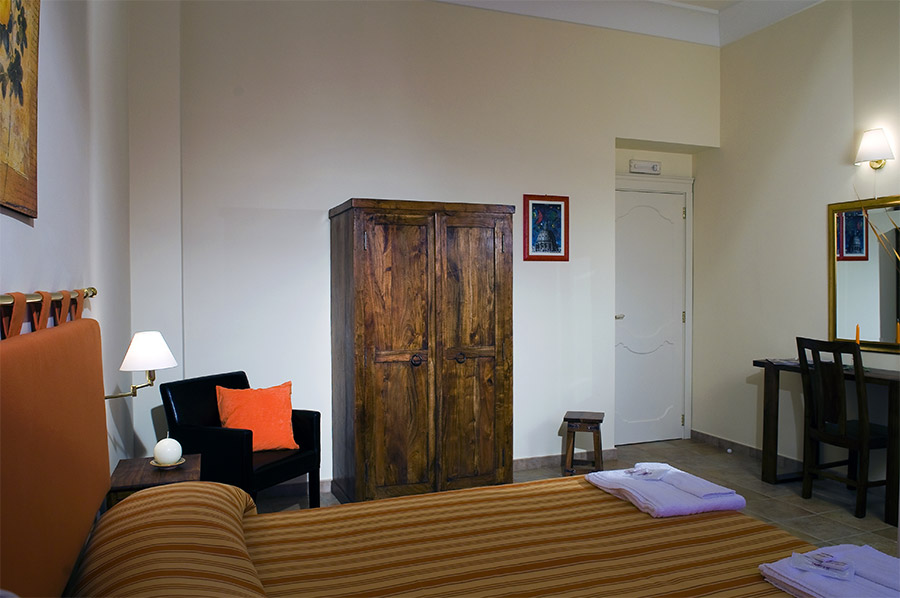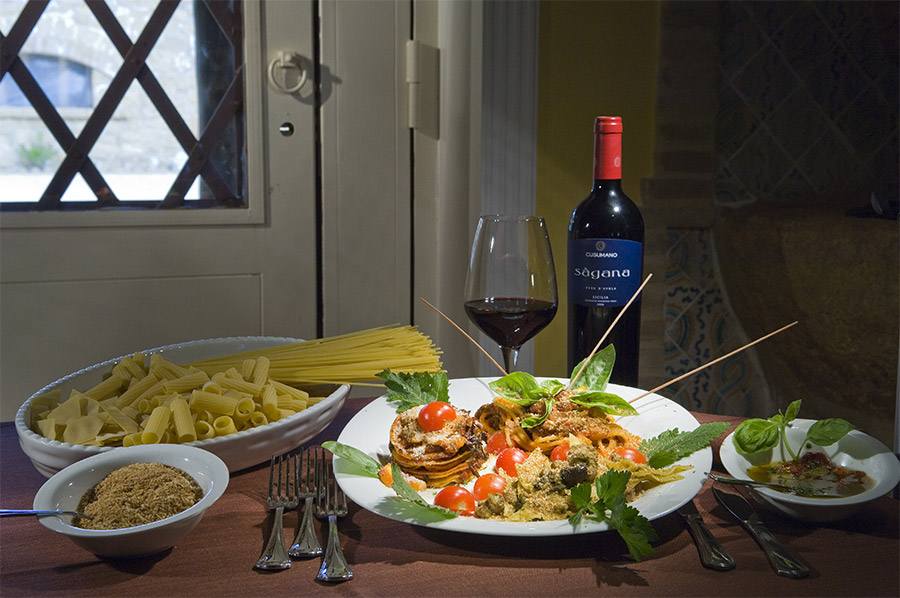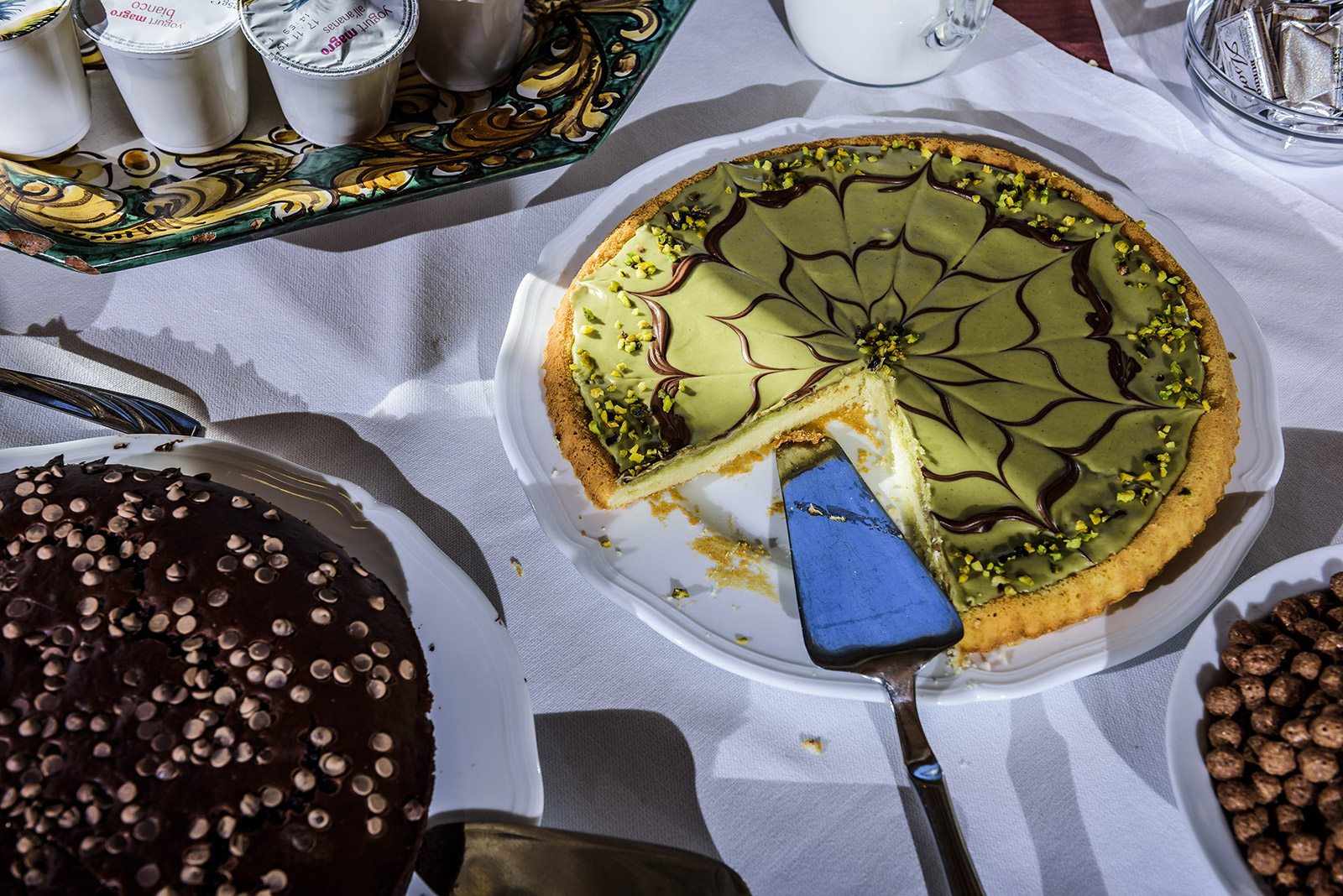Vorübergehend für die Öffentlichkeit geschlossen
BAUERNHAUS
ZIMMER
TIPOLOGIA DELLE CAMERE
- Camera doppia/matrimoniale,
- Camera tripla,
- Camere familiari per quattro/cinque persone, composte da due camere comunicanti con bagno.
SERVIZI INCLUSI
Pulizia giornaliera delle camere, uso della piscina panoramica arredata con lettini e zone d'ombra.
GASTRONOMIE UND KÜCHE
Unsere Speisekarte enthält Rezepte, die aus önogastronomischen Recherchen stammen, die wir sorgfältig durchgeführt haben, um unsere alte regionale Kochtradition wiederzuentdecken. Außerdem werden Sie die Möglichkeit haben, unsere typischen Produkte zu kosten, die von „Slow Food“ anerkannt sind.
Unser Agrotourismus-Hotel produziert auch exzellentes kaltgepresstes Olivenöl, köstliche Mandeln und knusprige Walnüsse.
AUSFLÜGE UND ABWECHSLUNG
Seine strategisch günstige Lage im Zentrum von Sizilien wird damit die Gäste bequem die Strände von Cefalu und die schönsten Städte Siziliens, wie Taormina, Agrigent, Palermo, Syrakus und Catania.
Die Gesellschaft organisiert kleine Konferenzen, Festivals, kulturelle und musikalische Veranstaltungen, Ausstellungen und Verkostungen der sizilianischen Handwerk.
Seine strategisch günstige Lage im Zentrum von Sizilien wird damit die Gäste bequem die Strände von Cefalu und die schönsten Städte Siziliens, wie Taormina, Agrigent, Palermo, Syrakus und Catania.
Die Gesellschaft organisiert kleine Konferenzen, Festivals, kulturelle und musikalische Veranstaltungen, Ausstellungen und Verkostungen der sizilianischen Handwerk.
AUSFLÜGE
Piazza Armerina (6 Km)
Piazza Armerina, a town with a population of about 20,000 people, is located on a hill in the area of the Erei Mountains, in central Sicily, at an altitude of 350 m and 30 Km away from Enna. This is one of the most important city in the region and is surrounded not only by the wonderful Parco della Ronza and other woods but also by marvellous natural sites, such as the irrigation reservoir Lake d'Olivo, the archaeological site surrounded by nature in Montagna di Marzo and the Rossomanno-Grottascura-Bellia Natural Reserve, part of which is located in the Piazza Armerina province.
Piazza Armerina is famous worldwide for its beautiful roman mosaics in Villa del Casale and has a lovely historical centre dominated by an elegant Dome, which was built on the highest hill (721 m) and is surrounded by narrow medieval streets and beautiful Renaissance and Baroque buildings, such as Palazzo Trigona and, not far away, the Aragonese Castle.
The historical town centre is very lively and it is full of Churches, Palaces, Monasteries and medieval streets that take us back in time and remind us of an ancient past which is well worth rediscovering.
Other places to see are the Four Medieval Districts of the city, one of which is the historical centre itself. They are full of historical buildings and every year, during the Norman Palio celebrated on Ferragosto (a holy day to commemorate the Assumption of the Virgin Mary), they compete to gain the flag of the Patron Saint, who is Our Lady of Victories.
Piazza Armerina is a town full of art and culture and it is the perfect destination for those who wish to have a pleasant and relaxing holiday. It represents an harmonic union between nature and human design. About 20,000 hectares of green, lush forests temper the climate even on the hottest summer days and make it a perfect holiday destination.
Further information: Turismo Piazza Armerina
Villa Romana del Casale (12 Km)
About 3 km southwest of Piazza Armerina, surrounded by a valley full of pines, elms, poplars and hazel trees, there is a beautiful monumental building known as Villa Romana del Casale. It was a luxurious residence owned by Massimiliano Erculeo, one of Diocletian’s counsellors, during the Roman Empire. It is famous worldwide for its mosaic pavements and has recently been made a UNESCO World Heritage Site.
This Villa had already been inhabited during the Arab period. Later it was partially destroyed by the Normans and then covered by a mud flood coming from Mount Mangone – and it remained under the mud for a long period of time.
In the 1920s, 1930s and 1940s experts began to study the site and the excavation works to uncover the Villa were started in the 1950s thanks to the support of the Region Sicily and the commitment of the archaeologist Vinicio Gentili.
The beauty and importance of this Villa lies in the perfect state of preservation of its mosaics, which are considered to be the widest and most fascinating mosaics ever made in the Roman Age.
Aidone and Morgantina (9 Km)
One of the most interesting archaeological sites in the Sicilian hinterland is doubtless the ancient Greek town of Morgantina, near Aidone, in the province of Enna. This town is located in a small valley surrounded by sweet hills and an Agora stands in the middle of this valley, dominated by “Colle della Cittadella” (Citadel Hill) where an acropolis was built. The area of the Agora is the most interesting part of the whole archaeological site in Morgantina.
The Greek Theatre is doubtless a remarkable place. Its semicircular cavea consists of 15 steps and is divided into six sections. It is possible that there weren’t only stone stairs but also wooden stairs in order to provide more seats (5,000 seats). The Chthonic Gods Sanctuary has a trapezoidal plan and archaeologists found polychrome votive busts representing Demeter inside it. To the east of the Greek Theatre there is a public granary from the 3rd century BC. It has a rectangular plan and there is some evidence that there were two furnaces inside it, which means that ceramic vases were produced there in the past.
Along the perimeter of the archaeological site it is still possible to see the ancient city walls, which followed the orographic features of the area and therefore have a very irregular layout. The towers that once stood in correspondence of the four entrances of the acropolis were completely destroyed and today we can only admire the remains of few ramparts and huts and the ruins of the city and the holy site.
The archaeological finds which were collected in the site in Morgantina are shown in the small but very beautiful Archaeological Museum located in Aidone. The most ancient items date back from the Iron Age and the most recent ones are from the 1st century BC.
Enna (40 Km)
Enna is the highest regional capital in Italy because it is located at an altitude of 1089 m on a hill in the area of the Erei Mountains, in central Sicily. It is the only Sicilian province that isn’t on the sea and has a population of about 173,000 people. The city boasts beautiful artistic and architectural buildings and a marvellous natural landscape that could make it one of the main touristic attraction in Sicily. Enna is also equipped with modern accommodation facilities, hotels, Agriturismi, B & B accommodations that however aren’t organized enough to promote tourism as much as other big art cities do.
The city of Enna is located on a mountain relief and in the past it was an important military stronghold. It was founded as a Greek colony and then became part of the Roman Empire but the period in which its most significant traits were determined is the Medieval period, when it was part of the reign of Frederic II of Swabia and of the Aragoneses.
Clear evidence of it is represented both by Castello Lombardia, of which only the perimeter towers survived, and Fredric II’s octagonal Tower located in the middle of the public park.
Enna’s Baroque Dome has a façade built in yellow tuff and a beautiful staircase. Inside it there are suggestive columns in black basalt with big pointed arches. Don’t miss the Regional Archaeological Museum in Palazzo Varisano, where there are beautiful items coming from archaeological excavation sites in the surroundings.
Further information: Turismo Enna
Pergusa Lake (34 Km)
Pergusa Lake is the only natural lake in central Sicily, it is located 5 km away from Enna and it generated as a result of a subsidence of the ground. It is famous because of the mythological legend of Proserpina, daughter of Ceres and Pluto: the legend tells that this lake was an entrance to the underworld – probably because of the reddish colour that the lake water has during certain periods of the year. The lake water is brackish because it comes from the rain as the lake doesn’t have neither tributaries nor outlets. From 1995 Pergusa Lake and the surrounding areas are considered as a Special Natural Reserve because they represent a lacustrine area with a very rich variety of avifauna and the only wet area in the heart of Sicily were migratory birds can rest.
Between April and May and between October and November, Pergusa becomes a real crossroads for birds both because of its geographical position and its wet climate, which makes it unique because the areas nearby are characterized by drought during most time of the year.
Pergusa is an ideal habitat for birds that fly non-stop for many hours from and to Africa. Thanks to a particular synergy between the microorganisms that populate the lake, it periodically creates a unique phenomenon: its water becomes red. This is due to a small crayfish that becomes red in order to protect itself from the sun and proliferates under water-plants. The crayfish leaves its red pigment in the water which consequently becomes reddish.
Further information: Turismoenna.it
Caltagirone (28 Km)
Caltagirone, a town with a population of 39,000 people, is located at an altitude of 611 m in the area of the Erei Mountains, in central Sicily. Its very ancient origin is witnessed by numismatic and artistic remains and documents that show it was one of the several Sicel or Greek-Sicel cities. In the area surrounding the city Greek and Sicel coins were found, too. In the Archaeological Museum in Syracuse, the Municipal Museums and the Ceramics Museum in Caltagirone there are also various beautiful ceramic and metal items.
Among the many religious events, baroque and popular feasts celebrated in Caltagirone, “La Scala Infiorata” is particularly fascinating. It takes place on the last Sunday in May and is characterized by a wonderful flower composition – made up of vases placed along the 142 steps of the staircase leading to the Church of St Mary of the Mount – to celebrate the Madonna of Condomini.
On 31st May there is a long procession, called “Rusedda”, with the typical “carri siciliani” (old donkey carts) and decorated tractors. On 25th July, the celebrations of St Jacob, the Patron Saint, which represent the most important religious event in the town, include a solemn mass, a procession and a traditional parade of people dressed in 18th century clothes. This symbolizes the arrival of the Norman Count Ruggero in Caltagirone, which was an important event for the history of the whole Island because it meant the end of the Arab domination and the beginning of the Norman one.
Particularly beautiful is the Scala Illuminata (lighted stairs) event: on 24th and 25th July, about 4,000 small oil-lamps wrapped in colored paper are placed along the staircase leading to the Church of St Mary of the Mount – following a layout that changes every year – and they lighted all together. At Christmas Caltagirone is full of stands and shops selling ceramic and terracotta nativity scenes and mangers – both modern and ancient but all handmade.
Ragusa Ibla (89 Km)
Ragusa has very ancient origins and its original centre Ibla is located at an altitude of 500 m. The newer part of the city was built between the 18th and the 19th centuries, is called Patro and is located at an altitude of 600 m. Ragusa and Ibla are the names given to two centres facing each other which were united after some historical events and then were separated again. But in 1926, when Ragusa became a regional capital, were finally united.
Ragusa’s historical district, despite the passing of time, is still fascinating and its current beauty is paradoxically due to the 1693 heart quake.
Ibla was able to rise again after the terrible quake that destroyed the Val di Noto area. Its late baroque and rococo buildings were built again with particular care and wisdom. Rosario Gagliardi was one of the leading figure in the reconstruction works and also designed the structure of the St George Dome. A part from its baroque pieces of art, Ibla has much more to offer: its quiet lanes, its splendid gardens in the lush valley of the Irmino River, the marvelous courtyards and the majestic palaces owned by an ancient nobility.
ANGEBOTE
So erreichen Sie uns
From Catania - Fontanarossa Airport (80 Km)
Take the A19 Highway direction Palermo, after 43 km exit at "Dittaino" (Zona industriale) and go straight on SP 75 direction Valguarnera - Piazza Armerina. After 2 km turn right on SS 192 for 6 km, then turn right on SP 4 direction Piazza Armerina (16 km).
Turn left and take the SS 117 BIS direction Piazza Armerina for 10 km.
Arrived at the south entrance of Piazza Armerina go straight on Alessandro Manzoni Street and then go on Macchiavelli Street for 150 meters and lastly turn right on Giosuè Carducci Street until the end of the street where you’ll find a traffic roundabout, turn left on SP16 direction Mirabella Imbaccari City for 3 km.
Follow the signs to the Agriturismo Salemi.
View the complete route on GMaps
From Palermo - Falcone Borsellino Airport (200 Km)
Take the A19 Highway direction Catania, after 120 km exit at "Enna", turn left and go straight on SS 117 BIS direction Enna bassa. After 6 km turn left on SS 561/Pergusina Street for 7 km, then turn left on SP 4 direction Piazza Armerina (3,5 km).
Turn left and take the SS 117 BIS direction Piazza Armerina for 10 km.
Arrived at the south entrance of Piazza Armerina go straight on Alessandro Manzoni Street and then go on Macchiavelli Street for 150 meters and lastly turn right on Giosuè Carducci Street until the end of the street where you’ll find a traffic roundabout, turn left on SP16 direction Mirabella Imbaccari City for 3 km.
Follow the signs to the Agriturismo Salemi SP 38.
View the complete route on GMaps
From Agrigento-Gela (116 Km)
Take the SS 117 BIS direction Piazza Armerina
Arrived at the south entrance of Piazza Armerina go straight on Alessandro Manzoni Street and then go on Macchiavelli Street for 150 meters and lastly turn right on Giosuè Carducci Street until the end of the street where you’ll find a traffic roundabout, turn left on SP16 direction Mirabella Imbaccari City for 3 km.
Follow the signs to the Agriturismo Salemi SP 38.
View the full path on GMaps
Arrived at Piazza Armerina (6 Km)
- Enter Piazza Armerina Sud
- Take Via Carducci to the Santa Croce roundabout
- Take the S. P. Piazza Armerina - Mirabella Imbaccari for about 3 km (towards Eremo)
- Turn left and follow the directions for Agriturismo Salemi SP 38
GPS coordinates
Lat. 37° 22' 27.85" N
Long 14° 24' 42.40" E
Richiesta di Contatto
Telefonnummern
+39 0935 686 432
Mobile & Whatsapp
+39 388 935 7761 (Whatsapp)
Adresse
94015 - Sicily - Italy
Lat. 37° 22' 27.85" N
Long 14° 24' 42.40" E













